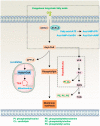The ACSL4 Network Regulates Cell Death and Autophagy in Diseases
- PMID: 37372148
- PMCID: PMC10295397
- DOI: 10.3390/biology12060864
The ACSL4 Network Regulates Cell Death and Autophagy in Diseases
Abstract
Lipid metabolism, cell death, and autophagy are interconnected processes in cells. Dysregulation of lipid metabolism can lead to cell death, such as via ferroptosis and apoptosis, while lipids also play a crucial role in the regulation of autophagosome formation. An increased autophagic response not only promotes cell survival but also causes cell death depending on the context, especially when selectively degrading antioxidant proteins or organelles that promote ferroptosis. ACSL4 is an enzyme that catalyzes the formation of long-chain acyl-CoA molecules, which are important intermediates in the biosynthesis of various types of lipids. ACSL4 is found in many tissues and is particularly abundant in the brain, liver, and adipose tissue. Dysregulation of ACSL4 is linked to a variety of diseases, including cancer, neurodegenerative disorders, cardiovascular disease, acute kidney injury, and metabolic disorders (such as obesity and non-alcoholic fatty liver disease). In this review, we introduce the structure, function, and regulation of ACSL4; discuss its role in apoptosis, ferroptosis, and autophagy; summarize its pathological function; and explore the potential implications of targeting ACSL4 in the treatment of various diseases.
Keywords: ACSL4; apoptosis; autophagy; cancer; ferroptosis.
Conflict of interest statement
The authors declare no conflict of interest.
Figures








Similar articles
-
Acyl-CoA synthase ACSL4: an essential target in ferroptosis and fatty acid metabolism.Chin Med J (Engl). 2023 Nov 5;136(21):2521-2537. doi: 10.1097/CM9.0000000000002533. Chin Med J (Engl). 2023. PMID: 37442770 Free PMC article. Review.
-
ACSL4-Mediated Ferroptosis and Its Potential Role in Central Nervous System Diseases and Injuries.Int J Mol Sci. 2023 Jun 12;24(12):10021. doi: 10.3390/ijms241210021. Int J Mol Sci. 2023. PMID: 37373168 Free PMC article. Review.
-
ACSL4-dependent ferroptosis does not represent a tumor-suppressive mechanism but ACSL4 rather promotes liver cancer progression.Cell Death Dis. 2022 Aug 13;13(8):704. doi: 10.1038/s41419-022-05137-5. Cell Death Dis. 2022. PMID: 35963845 Free PMC article.
-
Inhibition of ACSL4 ameliorates tubular ferroptotic cell death and protects against fibrotic kidney disease.Commun Biol. 2023 Sep 5;6(1):907. doi: 10.1038/s42003-023-05272-5. Commun Biol. 2023. PMID: 37670055 Free PMC article.
-
Ischemia-induced ACSL4 activation contributes to ferroptosis-mediated tissue injury in intestinal ischemia/reperfusion.Cell Death Differ. 2019 Nov;26(11):2284-2299. doi: 10.1038/s41418-019-0299-4. Epub 2019 Feb 8. Cell Death Differ. 2019. PMID: 30737476 Free PMC article.
Cited by
-
Comprehensive analysis of cuproptosis-related genes involved in immune infiltration and their use in the diagnosis of hepatic ischemia-reperfusion injury: an experimental study.Int J Surg. 2025 Jan 1;111(1):242-256. doi: 10.1097/JS9.0000000000001893. Int J Surg. 2025. PMID: 38935114 Free PMC article.
-
A new nano approach to prevent tumor growth in the local treatment of glioblastoma: Temozolomide and rutin-loaded hybrid layered composite nanofiber.Asian J Pharm Sci. 2024 Dec;19(6):100971. doi: 10.1016/j.ajps.2024.100971. Epub 2024 Oct 23. Asian J Pharm Sci. 2024. PMID: 39640055 Free PMC article.
-
COP1 drives renal cell carcinoma progression by targeting ACSL4 for ubiquitin-mediated degradation and inhibiting ferroptosis.Front Oncol. 2025 May 6;15:1570727. doi: 10.3389/fonc.2025.1570727. eCollection 2025. Front Oncol. 2025. PMID: 40395328 Free PMC article.
-
Role of ACSL4 in modulating farnesoid X receptor expression and M2 macrophage polarization in HBV-induced hepatocellular carcinoma.MedComm (2020). 2024 Sep 12;5(9):e706. doi: 10.1002/mco2.706. eCollection 2024 Sep. MedComm (2020). 2024. PMID: 39268355 Free PMC article.
-
Blocking ACSL6 Compromises Autophagy via FLI1-Mediated Downregulation of COLs to Radiosensitize Lung Cancer.Adv Sci (Weinh). 2024 Oct;11(40):e2403202. doi: 10.1002/advs.202403202. Epub 2024 Aug 29. Adv Sci (Weinh). 2024. PMID: 39206814 Free PMC article.
References
Publication types
LinkOut - more resources
Full Text Sources

